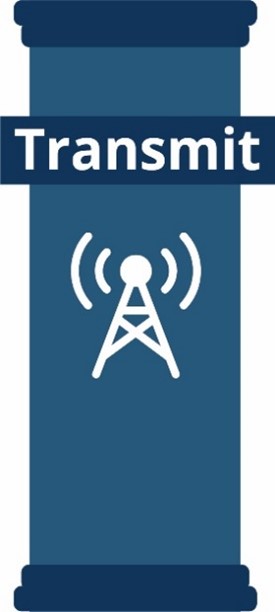Editor’s Note: Given the lingering questions surrounding employee disengagement and the connection to customer loyalty, The Wise Marketer has put together a new thought leadership series we hope will shed some light on the topic. We have asked the Employee Engagement experts at Hinda Loyalty to offer a framework for understanding and attacking the issues facing so many of our readers. The 5-part series began with an introduction to The Four Pillars of the New Employee Relationship. The first two pillars, Attracting the Right Personnel and How to Engage, were published previously.
The next entry in the series focuses on the Third Pillar: How to Transmit to Employees. Reader participation and feedback is always welcomed. We’ll continue the series throughout the summer and conclude with a webinar (registration available here) bringing it all together.
By: Theresa Thomas, CLMP™, Hinda and Ric Neeley, Hinda
Welcome to the 3rd installment of the 4 Pillars of the New Employee Relationship.
Hopefully, you’ve read the first three posts: the series introduction, Pillar #1 - Attract, and Pillar #2 - Engage.
As we mentioned in the introduction, the four Pillars are Attract, Engage, Transmit and Advocate. While this series of articles is presenting those Pillars as separate entities, they are connected. You can’t work on just one Pillar and expect to have employee engagement or retention. The Pillars work together as a team to drive engagement in your organization. And, as you know, every winning team has a great coach. Your company — and its “employee team” is no different. If you want to be a winning organization, you need a great team and a great coach. Or, as in a corporate situation, multiple coaches.
It’s About Their Experience
Employee engagement and retention isn’t an enterprise problem. The responsibility for creating and maintaining employee engagement doesn’t sit in a particular office, nor is it attached to a particular department or title. It requires a team of people pulling together to create and maintain engagement.
Employee engagement, like culture, is influenced as much by one’s individual experiences as it is by the sum total of experiences of all the employees.
To quote Investopedia:
“Corporate culture refers to the beliefs and behaviors that determine how a company's employees and management interact and handle outside business transactions. Often, corporate culture is implied, not expressly defined, and develops organically over time from the cumulative traits of the people the company hires.”
Culture — and we’d argue, engagement — is soft, squishy, and based on the sum total of experiences — not just one person, one document, or one policy. That is why your “coaches” are so critical in making sure the entire organization is engaged. They are the transmission lines for engagement and culture. And they all need to be sending the same signal.
Engagement is Transmitted Through Humans
Maybe 2022 is not the year to talk about “transmission” — that word has unique baggage now — but that is exactly how engagement, retention, and culture spread through an organization. It is transmitted by the people.
Humans will listen to, and believe, other humans more than a faceless “corporation.” When companies rely on technology or a process to create engagement and impact retention, they are removing the human, and ultimately, removing engagement. When a platform is considered the solution, the tool ends up used infrequently, or used frequently but incorrectly, creating issues of favoritism and unintended consequences. You can’t buy an employee engagement platform and think you can set it and forget it. That only works with a Ron Popeil Rotisserie and BBQ oven.
Create Lines of Transmission
In order to have great culture, great engagement and great retention, you need an engaged and trained management team. These are your company’s coaches. These are the people who transmit the goals and objectives of the company into day-to-day behaviors. These are the people who are tasked with modeling appropriate behaviors and communicating the company’s mission and values. Their behaviors are the visible evidence of the company’s culture and engagement.
But if your coaching staff isn't focused on the mission, or they lack the skills to engage their staff, engagement cannot happen. Period. Full stop.
The statement, “People don’t leave companies, they leave their manager” is said so often it sounds cliché. But it’s a warning executives should heed. Upskilling and training management about the science and practice of engagement — rewards, recognition, appreciation, and communication — is the single biggest factor driving engagement and reducing turnover.
Managers are a linchpin in the engagement equation.
So, the question you need to ask yourself is this: How much of your engagement strategy ends up focusing on “take your goldfish to work days” and pizza lunches, instead of manager training?
How to Build Stronger Transmission Lines
Knowing that managers are critical for retention and engagement, you would expect managers to receive a ton of training on this part of their job. But sadly, that is not the case. Too often managers believe and are reviewed on how well they “keep the trains running on time”. Tactical outputs become a proxy for management performance, when in reality management performance should be measured on how well the people on their team are ENGAGED with keeping the trains running on time.
Dr. Beverly Kaye, author of the bestselling book “Love ‘Em or Lose ‘Em: Getting Good People to Stay”, offered advice on how to encourage retention at the CIO’s recent Future of Work Summit.
1) Great managers ensure their staff get training, get opportunities, get noticed.
Growth in a job is critical. If people do not feel they are growing, they will not stay. And they’ll leave if they don’t feel their managers care about their growth.
2) Assume your staff can leave at any moment.
More critical now than ever, with the “great resignation”, managers need to be operating as if their new hire could be recruited away immediately — and should continuously recruit them with opportunities for growth.
3) Remote workers may need more love now.
With remote work — and the difficulty of real-life bonding increasing — managers must work harder to create human connections. Managers need to reach out to their employees through every medium and mode available, e.g. text, email, Slack, phone (yeah – that is still a thing), smoke signals, whatever tool they can.
4) ALL employees are saying, “I want to be noticed. I want to be rewarded.”
People haven’t changed in thousands of years. We are all still driven by basic rules of engagement. One of the most axiomatic is people want you to notice them. Managers need to get comfortable with recognition. They want managers to give ongoing feedback.
5) Employees feel they are not getting all the information they should be getting.
Communicate. Communicate. Communicate. Managers need to do more to ensure they are having enough conversations with their employees AND as important — make sure they are addressing the issues of the individual employee. Are your managers asking their teams what they need to know? What are the employees not hearing but think they should? In other words, bring them inside the circle.
Finally, managers need to be sure they are doing everything possible to engage and lean into the employees' passions. If an employee is a dog lover, is there a project you can assign that matches that value to a work function? Managers who can connect personal and professional goals will win every time.
Enabling Engagement = Management Tasks
Here is the obvious net-net for “Transmit”. Every one of the things we discussed in our “Engage” post are things managers need to enable and empower. Employees are engaged when their managers work to make sure they have the things they need, e.g. communication, recognition, appreciation, growth.
Organizations MUST put more effort and time into training managers on the drivers of employee engagement and measure them on what they are personally doing to create engagement.
Don’t Forget. Get Priority Access
If you didn’t do it with any of our previous posts in this series, then take a minute and click here to sign up for early access to our complimentary eBook and a reserved spot for our webinar around the 4 Pillars. The webinar will cover all the information in this whole series and during which you’ll have the opportunity to ask questions and engage in dialogue that will help you drive greater employee engagement and advocacy.





